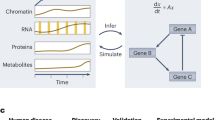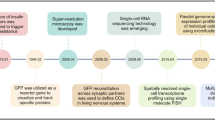Abstract
As research institutions prepare roadmaps for “systems medicine,” we ask how this differs from applications of systems biology approaches in medicine and what we (should) have learned from about one decade of funding in systems biology. After surveying the area, we conclude that systems medicine is the logical next step and necessary extension of systems biology, and we focus on clinically relevant applications. We specifically discuss three related notions. First, more interdisciplinary collaborations are needed to face the challenges of integrating basic research and clinical practice: integration, analysis, and interpretation of clinical and nonclinical data for diagnosis, prognosis, and therapy require advanced statistical, computational, and mathematical tools. Second, strategies are required to (i) develop and maintain computational platforms for the integration of clinical and nonclinical data, (ii) further develop technologies for quantitative and time-resolved tracking of changes in gene expression, cell signaling, and metabolism in relation to environmental and lifestyle influences, and (iii) develop methodologies for mathematical and statistical analyses of integrated data sets and multilevel models. Third, interdisciplinary collaborations represent a major challenge and are difficult to implement. For an efficient and successful initiation of interdisciplinary systems medicine programs, we argue that epistemological, ontological, and sociological aspects require attention.
Similar content being viewed by others
Log in or create a free account to read this content
Gain free access to this article, as well as selected content from this journal and more on nature.com
or
References
Wolkenhauer O, Fell D, De Meyts P, et al. SysBioMed report: advancing systems biology for medical applications. IET Syst Biol 2009;3:131–6.
Wolkenhauer O, Auffray C, Baltrusch S, et al. Systems biologists seek fuller integration of systems biology approaches in new cancer research programs. Cancer Res 2010;70:12–3.
Kreeger PK, Lauffenburger DA . Cancer systems biology: a network modeling perspective. Carcinogenesis 2010;31:2–8.
Khoury MJ, Gwinn M, Dotson WD, Schully SD . Knowledge integration at the center of genomic medicine. Genet Med 2012;14:643–7.
Dammann O, Follett P . Toward multi-scale computational modeling in developmental disability research. Neuropediatrics 2011;42:90–6.
Tegnér JN, Compte A, Auffray C, et al. Computational disease modeling - fact or fiction? BMC Syst Biol 2009;3:56.
Kohl P, Noble D . Systems biology and the virtual physiological human. Mol Syst Biol 2009;5:292.
Wolkenhauer O, Hofmeyr J . Interdisciplinarity as both necessity and hurdle for progress in the life sciences. In: Andersen H, Dieks D, Gonzales WJ, Uebel T, Wheeler G, eds. New Challenges to Philosophy of Science - The Philosophy of Science in a European perspective 4. Amsterdam, The Netherlands: Springer Verlag, in press.
Cohen JE . Mathematics is biology’s next microscope, only better; biology is mathematics’ next physics, only better. PLoS Biol 2004;2:e439.
Wolkenhauer O, Shibata D, Mesarovic MD . The role of theorem proving in systems biology. J Theor Biol 2012;300:57–61.
Green S, Wolkenhauer O . Integration in action. EMBO Rep 2012;13:769–71.
Dammann O, Gressens P . Integrated mechanism reviews. Pediatr Res 2012;71:530–1.
Hood L, Balling R, Auffray C . Revolutionizing medicine in the 21st century through systems approaches. Biotechnol J 2012;7:992–1001.
del Sol A, Balling R, Hood L, Galas D . Diseases as network perturbations. Curr Opin Biotechnol 2010;21:566–71.
ERASysBio Partners. Systems biology in the European research area (a report - March 2008). (http://www.erasysbio.net/lw_resource/datapool/__pages/pdp_2/ERASysBio_Systems_Biology_Strategy_Paper_25-Mar-2008.pdf). Accessed 1 October 2012.
Auffray C, Chen Z, Hood L . Systems medicine: the future of medical genomics and healthcare. Genome Med 2009;1:2.
European Science Foundation. Advancing systems biology for medical applications (a science policy briefing no 35 - December 2008). (http://www.esf.org/nc/research-areas/medical-sciences/activities/science-policy/advancing-systems-biology-for-medical-applications.html). Accessed 1 October 2012.
National Institute of General Medical Sciences. Quantitative and systems pharmacology in the post-genomic era: new approaches to discovering drugs and understanding therapeutic mechanisms (an NIH white paper by the QSP workshop group - October 2011). (http://www.nigms.nih.gov/NR/rdonlyres/8ECB1F7C-BE3B-431F-89E6-A43411811AB1/0/SystemsPharmaWPSorger2011.pdf). Accessed 1 October 2012.
Acknowledgements
Parviz Minoo served as the deciding editor for this article.
Author information
Authors and Affiliations
Corresponding author
Rights and permissions
About this article
Cite this article
Wolkenhauer, O., Auffray, C., Jaster, R. et al. The road from systems biology to systems medicine. Pediatr Res 73, 502–507 (2013). https://doi.org/10.1038/pr.2013.4
Received:
Accepted:
Published:
Issue date:
DOI: https://doi.org/10.1038/pr.2013.4
This article is cited by
-
New perspectives: systems medicine in cardiovascular disease
BMC Systems Biology (2018)
-
Deblender: a semi−/unsupervised multi-operational computational method for complete deconvolution of expression data from heterogeneous samples
BMC Bioinformatics (2018)
-
Mechanistic and topological explanations in medicine: the case of medical genetics and network medicine
Synthese (2018)
-
Systems biology of eukaryotic superorganisms and the holobiont concept
Theory in Biosciences (2018)
-
A computational framework for complex disease stratification from multiple large-scale datasets
BMC Systems Biology (2018)



